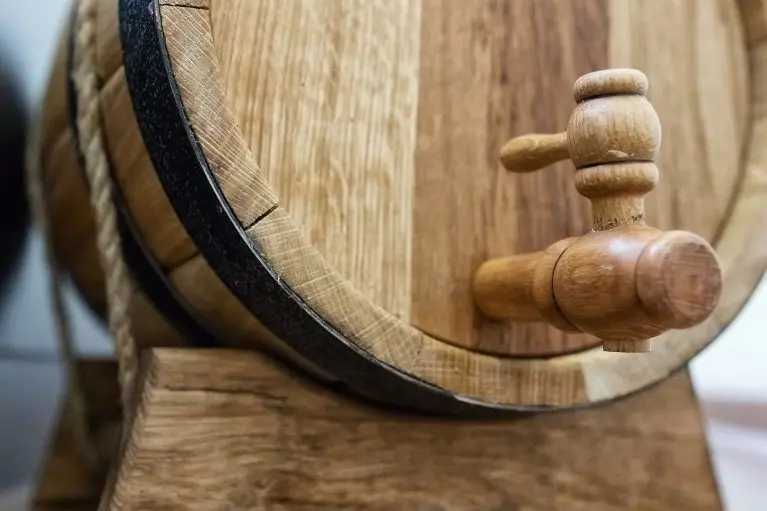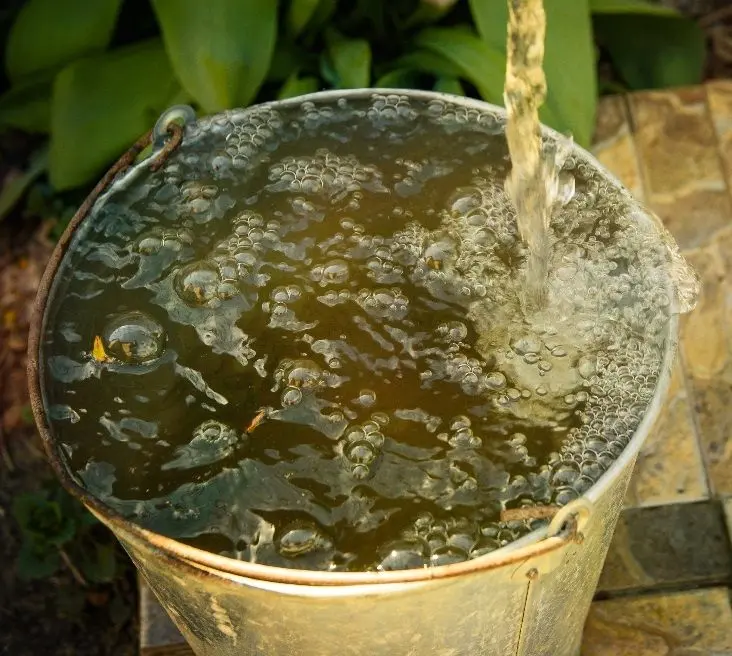The wood of a new barrel contains too many tannins – tannins, the concentration of which must be reduced. If wine or distillate is poured into an oak barrel without preliminary preparation, then the alcohol will quickly become cloudy, then an unpleasant tart aftertaste will appear, which has received the popular name “plinth”. Soaking a barrel takes time, patience and a lot of water.
In home distilling, it is better to use barrels with a volume of 2 to 10 liters. The smaller the volume, the faster the wood gives off tannins, which reduces the exposure time. The reason is the area of contact with alcohol. For example, in a five-liter barrel, 1 liter of drink comes into contact with 400 square meters. cm of wood, and in a fifty-liter one – only from 152 sq. see Accordingly, the maturation period of moonshine, cognac or wine in a large container increases significantly.
Barrels from 10 to 50 liters are suitable only for long-term aging of strong drinks. During maturation, part of the content evaporates through the pores of the wood. Regardless of the volume of the barrel, losses are up to 1 liter per year; in cognac production technology, this evaporation is called the “angels’ share”. If you pour distillate into a small barrel, after 5 years there will be almost nothing left inside.
I advise you to buy already waxed oak barrels. Waxing protects the wood from external factors, prolonging its life, preventing leaks and making the barrel more beautiful. At the same time, wax does not affect gas exchange, the drink continues to “breathe” normally through the pores. It is also desirable that the barrel was without a tap, as this is the most vulnerable structural element, which often gives a strong leak. At one point, all the contents may be on the floor. For a beautiful presentation, it is better to buy a small barrel of 1-3 liters and pour the drink there before the guests arrive.

Barrel preparation technology
1. Fill a new barrel with 90% of the volume of clean, filtered water at room temperature, close the cork and leave for 3-4 hours.
2. Check the barrel for leaks by carefully inspecting the wood around the perimeter of the rings, then the bottom front and back. A slight leak is not critical, this problem will resolve itself in the next step, when the wood swells. The main thing is that there is no jet, since such a barrel is considered full of holes and needs to be repaired.
3. Fill the barrel to the top with water, close tightly and transfer to a room with room temperature. If leakage is observed, add water every 12 hours until the leakage stops. After 3 days, drain the water (it will be dirty brown or yellow), then pour in a new batch of clean water.

4. After a day, drain the water, add boiling water to the barrel (1 liter per 10 liters of volume), close tightly and swing the product from side to side several times so that the boiling water washes the entire inner surface of the barrel. After 45 minutes, fill to the top with water and close tightly.
5. After 24 hours, change the water again. The process of soaking the barrel (daily replacement of cold water) is repeated until the last water becomes clear, tasteless and odorless. This usually takes three to six weeks.
6. Boil water (50% of the volume of the barrel), then cool to 70-75°C, add soda (20 grams per 1 liter), mix and pour into the barrel. Shake vigorously for 8-10 minutes, then drain the soda solution.
7. Pour hot water over the entire volume of the barrel, hold for 15 minutes, drain, and fill again with clean cold water, which should be poured out after 8-10 hours.
8. If the barrel is intended for strong drinks (moonshine, cognac, whiskey, bourbon), the container is ready for use. In the case of wine, I recommend first aging odorless double distillate diluted to 30-45 degrees for 18-20 days.
In addition to the volume of the barrel, the aging result is influenced by: air humidity (optimal 80-85%), temperature (10-12°C for wine, 14-16°C for strong alcohol) and brewing time. Process control is carried out by periodic tests. When the taste suits, the drink is poured into glass containers for long-term storage.









